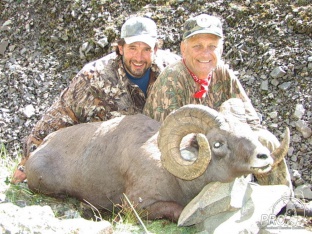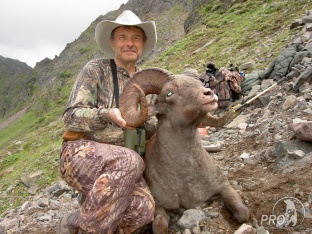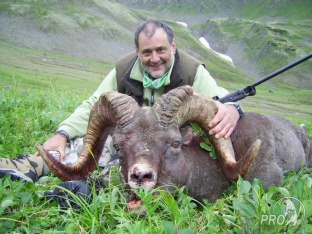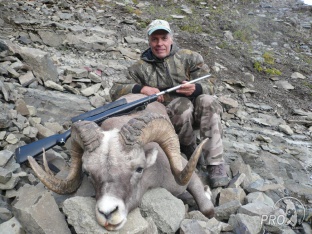Kamchatka Snow Sheep
Kamchatka snow sheep (Ovis nivicola nivicola), Carnero de las nieves de Kamchatka (Sp), Kamchatka Schneeschaf (G), Mouflon des neiges du Kamtchatka (F). Sometimes incorrectly called Kamchatka bighorn, but it is actually a thinhorn, the same as other snow sheep and also the Dall and Stone sheep of North America. Color is grayish-brown or grizzled. The white rump patch is rather small and is divided by a dark stripe that continues down the tail. Muzzle is white, but the brown facial band, which so strongly characterizes the Verkhoyansk population to the west, is almost lost. Head and neck may show a varying degree of grayish-white. The horns protrude outward, around and down in almost 1-1/2 curls to perfect, unbroomed tips. The two longest-horned snow sheep of record are from Kamchatka, one with horns measuring 41.7 and 40.9 inches (105.9 and 103.9 cm), the other with horns of 41.7 and 39.5 inches (105.9 and 100.3 cm). These heads are superb, with the horns pinching close to the face, then sweeping outward, around and down in almost 1-1/2 curls to perfect, unbroomed tips.
Areas
Kamchatka peninsula, South Kamchatka – Milkovo region
Route
One option is to fly to Kamchatka direct from Anchorage, Alaska by local Russian Airlines. There are no regular flights all year around but usually during summer-season charter flights once a week are available. Depart Anchorage at in the morning on Monday with arrival in Petropavlovsk at in the morning on Tuesday. Depart Petropavlovsk at late afternoon on Monday, arrival in Anchorage on Monday in the morning.
Another option is travelling via Moscow with Aeroflot. Flight from Moscow to Kamchatka is 8,5-hour non-stop flight. It is a daily flight. In Moscow / Petropavlovsk you will be met by our crew and assisted through customs.
Then you will be chartered into the camp by helicopter.
Hunting season
The season is from August 1 to September 30. Best time is in August. Snow sheep hunting can be combined nicely with Kamchatka Bear from the 1up>st of September.
Hunting
For the most part a backpack hunt is traditional, and only in some areas horseback hunts on Kamchatka sheep are available. Each hunter normally will have one guide and one assistant. Backpack and lots of hard hunting on foot can be expected. You should be in good shape. A temporary tented camp is set up with the specific goal of hunting a particular animal or area. We do not promise you to see very many rams, but we strive to make your hunt successful.
Camp and accommodation
Base camps are modern windproof tents. They are equipped with stoves and cots. There are separate large tents for dining and one for shower. The camps are located in mountain valleys at 2,500–3,000 feet (800-1,000 m). Every base camp has a cook, who can offer you home style meals. You will find a very good food and a quality service. Electricity is supplied by generating sets. Spike camps with small tents are used during the hunt.
Climate
In August during daylight hours the temperature is 40 to 50 oF (15 to 25 oC) and during night from 32 to 40 oF (0 to 10 oC). Late in the season rainy, snowy and windy weather is possible.
Schedule
| Day 1 | arrival in Petropavlovsk, helicopter (approx. 1 hour) or ground transfer to the hunting area |
| Day 2-11 | 10 day hunt |
| Day 12 - 13 | transfer back to Petropavlovsk, overnights at the hotel (one or two depending on kind of transportation) |
| Day 14 | departure from Petropavlovsk |




